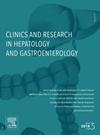Comparing baseline VAF in circulating tumor DNA and tumor tissues predicting prognosis of patients with colorectal cancer liver metastases after curative resection
IF 2.6
4区 医学
Q2 GASTROENTEROLOGY & HEPATOLOGY
Clinics and research in hepatology and gastroenterology
Pub Date : 2024-09-12
DOI:10.1016/j.clinre.2024.102464
引用次数: 0
Abstract
Introduction
The prognostic value of baseline variant allele frequency (VAF) in circulating tumor DNA (ctDNA) of colorectal cancer liver metastases (CRLM) patients after curative resection was rarely investigated.
Methods
A single-center prospective study was performed to investigate the prognostic impact of baseline VAF in ctDNA and matched tumor tissues of CRLM patients after curative resection between May 2019 and May 2021 by the Illumina NovoSeq 6000 platform. The relationship of the tumor burden score (TBS) and the VAF in ctDNA and matched tumor tissues was evaluated by the Pearson correlation method. The survival curves of recurrence-free survival (RFS) and overall survival (OS) were plotted. Factors associated with RFS were calculated using Cox regression analysis, and an integrated prognostic model using significant baseline variables was proposed.
Results
There were 121 patients with baseline ctDNA and matched tumor tissues enrolled in the study. A total of 417 mutations spanning 20 genes were identified in baseline tumor tissues of 119/121 (98.3 %) cases. The overall mutations in tumor tissues were completely covered by ctDNA in 52 of 121(43.0 %) patients. Baseline VAF in ctDNA but not in tumor tissues was significantly correlated to TBS of CRLM (R = 0.36, p < 0.001). Significantly longer RFS but not OS was observed in patients with lower VAF in ctDNA compared to those with higher one (p < 0.001 and p = 0.33 respectively). Multivariate Cox regression analysis showed higher VAF in baseline ctDNA was an independent risk factor for RFS. An integrated prognostic model including baseline metastasis location and VAF in ctDNA outperformed the traditional CRS model in predicting RFS.
Conclusion
Baseline VAF in ctDNA but not in tumor tissues influenced RFS of CRLM patients after curative resection.
比较循环肿瘤DNA和肿瘤组织中的基线VAF,预测切除术后结直肠癌肝转移患者的预后
导言:结直肠癌肝转移(CRLM)患者根治性切除术后循环肿瘤DNA(ctDNA)中基线变异等位基因频率(VAF)的预后价值很少被研究:一项单中心前瞻性研究通过Illumina NovoSeq 6000平台研究了2019年5月至2021年5月期间治愈性切除术后CRLM患者ctDNA和匹配肿瘤组织中基线VAF的预后影响。采用皮尔逊相关法评估了肿瘤负荷评分(TBS)与ctDNA和匹配肿瘤组织中VAF的关系。绘制了无复发生存率(RFS)和总生存率(OS)的生存曲线。利用Cox回归分析计算了与RFS相关的因素,并提出了一个利用重要基线变量的综合预后模型:结果:共有121名具有基线ctDNA和匹配肿瘤组织的患者参与了研究。在 119/121 例(98.3%)患者的基线肿瘤组织中,共发现了 20 个基因的 417 个突变。121例患者中有52例(43.0%)的肿瘤组织中的突变完全被ctDNA覆盖。ctDNA中的基线VAF而非肿瘤组织中的VAF与CRLM的TBS显著相关(R=0.36,p):ctDNA中的基线VAF而非肿瘤组织中的VAF会影响CRLM患者根治性切除术后的RFS。
本文章由计算机程序翻译,如有差异,请以英文原文为准。
求助全文
约1分钟内获得全文
求助全文
来源期刊

Clinics and research in hepatology and gastroenterology
GASTROENTEROLOGY & HEPATOLOGY-
CiteScore
4.30
自引率
3.70%
发文量
198
审稿时长
42 days
期刊介绍:
Clinics and Research in Hepatology and Gastroenterology publishes high-quality original research papers in the field of hepatology and gastroenterology. The editors put the accent on rapid communication of new research and clinical developments and so called "hot topic" issues. Following a clear Editorial line, besides original articles and case reports, each issue features editorials, commentaries and reviews. The journal encourages research and discussion between all those involved in the specialty on an international level. All articles are peer reviewed by international experts, the articles in press are online and indexed in the international databases (Current Contents, Pubmed, Scopus, Science Direct).
Clinics and Research in Hepatology and Gastroenterology is a subscription journal (with optional open access), which allows you to publish your research without any cost to you (unless you proactively chose the open access option). Your article will be available to all researchers around the globe whose institution has a subscription to the journal.
 求助内容:
求助内容: 应助结果提醒方式:
应助结果提醒方式:


